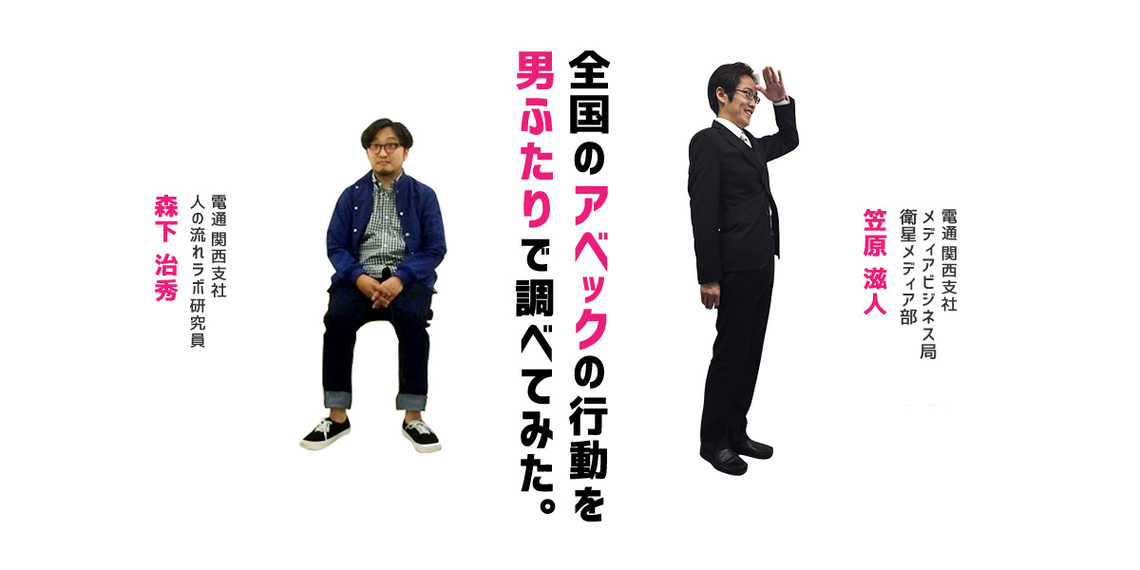
Surprise reappearance. I'm Shigeto Kasahara from Dentsu Inc. Kansai's " Human Flow Lab " (*1). Spring is here. It's the season of meetings and partings. In other words, a time of dynamic human connections. You could also say it's the season when couples are most likely to form. Wait, you don't know what "couple" means!? "Couple" refers to two people who are dating. Personally, "couple" feels more fitting than "dating pair," so I'll mainly use "couple" in this article!
Come spring, couples sprout; through summer and fall, they nurture their love; and by winter, I find myself pondering things like, "What are couples around the world doing, and in what ways?" It was then I heard that VCNC Japan's couple-exclusive app " Between " (*2) conducted a Christmas-themed survey among its users late last year.
So, based on that survey results, we decided to investigate where couples go and how much they spend, broken down by area. Just like last time, I teamed up with the little old man Haruhide Morishita from the "Human Flow Lab" – two guys observing couples' behavior. This time, to rein in the two old guys' wild behavior, we also enlisted the help of Mari Takada from "Gal Lab@" (※3) as an observer to study couples' actions.
Hearts are already in Christmas mode. Observing how couples spend their time based on survey results from the popular couple app "Between"
The survey was conducted in November 2015 as a "Couples' Christmas Survey" targeting 3,377 people. The gender ratio of respondents was 74.1% female and 25.9% male.
A representative from VCNC Japan told us, "Even though we say 'couples,' there are many different types depending on how long they've been together and their age group." We thought that by looking at the areas where "Between" survey respondents live and their actual movement and behavior patterns, we might uncover hints for marketing activities targeting couples.
Couples fall into two groups: "Stay-at-home types" and "Out-and-about types." Which are you?

When examining the top responses to the question "How do you spend Christmas?" by prefecture, we found a balanced split: regions where "viewing illuminations" ranked first and regions where "spending time at (one partner's) home" ranked first. In other words, couples were divided into "homebodies" and "out-and-abouts." We decided to delve deeper into the "behavior" of these two types of couples.
Pair gifts are popular. Different trends for "home" and "outing" groups!?
The most popular gift for both the stay-at-home and go-out groups was "pair goods"!
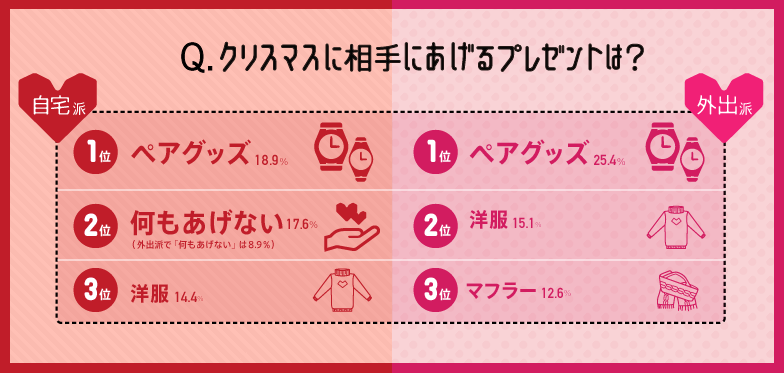
To us, matching items feel both enviable and a little embarrassing, but they seem to be the most popular Christmas gift.
We asked Gal Labo's Mari Takada to gather real voices. According to a 19-year-old female college student living in Tokyo,
"My boyfriend gives me matching items like hoodies or mugs for anniversaries. Sometimes we even go out wearing matching hoodies."
So, for modern couples, matching items are a welcome staple gift.
The rankings for 2nd place and below differ between the "stay-at-home" and "go-out" groups. For the go-out group, 2nd place is "clothes," followed by 3rd place "scarves"... However, for the stay-at-home group, 2nd place is "nothing at all." Clothes come in 3rd. It seems going out makes people more inclined to give gifts. At home, even on Christmas, the everyday feeling remains, leading to thoughts like "Well, maybe no gift is fine." The biggest difference between home and out-and-about groups was this "nothing at all" response, with 8.9% of out-and-about groups and 17.6% of home groups choosing it.
Clothing was popular among both groups. Giving clothes as a gift seems tricky, but it's a skill only possible because you know their tastes, preferences, and most importantly, their measurements. Kudos to the couples who masterfully use "Between".
Naturally, the average gift amount was higher among the "Outing Group".
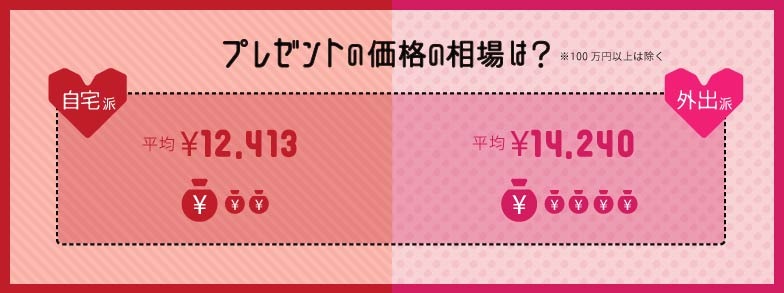
Calculating the average amount spent on gifts, the "go out" group naturally spent more. Since many in the "stay home" group "don't give anything," this result is only natural. Whether the roughly ¥2,000 difference in average gift amount is considered large or small is hard to say. We also analyzed responses by generation (age), and it's worth noting that across nearly all age groups, "stay home" was less than "go out."
The average relationship duration for the "stay-at-home group" was 23.4 months, while for the "go-out group" it was 19.6 months.
There was also a difference in "length of relationship" between home-stayers and out-goers.
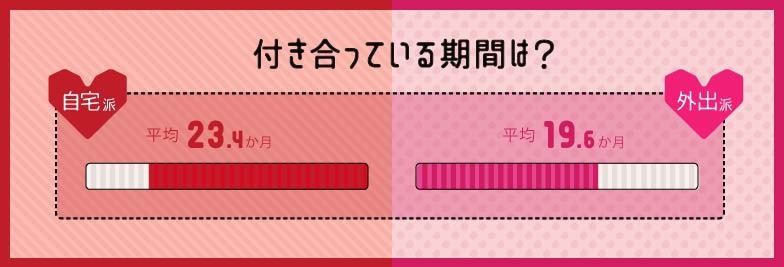
As the relationship lengthens, it seems they inevitably hit a rut. What started as "going out" together – a positive break from the "everyday" – gradually shifts to "spending time at home," becoming part of the "everyday" as the relationship progresses.
Once again, we asked Gal Lab @ Mari Takada to gather real voices. A 21-year-old female university student living in Kyoto, who has been dating her current boyfriend for about two years, said she didn't receive a Christmas present. "We've been together for a while now, and I feel a bit embarrassed about exchanging presents specifically for Christmas," she explained.
Therefore,
・Long relationship duration = Spending time together is routine = Staying home = Less gift-giving
・Short relationship duration = Spending time together is special = Going out = Exchanging gifts
This pattern emerges.
Habitat Map of "Home-Stayers" and "Out-Doers"
Next, in true "Human Flow Lab" style, we looked at which regions have more home-based or out-and-about types, as shown in the figure below. Regions with more out-and-about types vaguely reveal relatively well-developed public transportation systems.
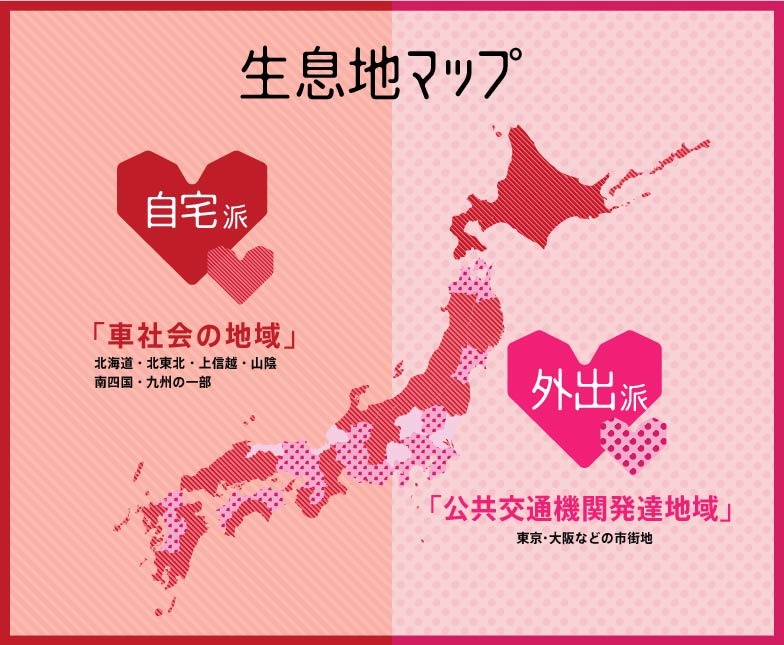
Tokyo, Osaka, Aichi, and their surrounding areas have well-developed JR and private railways, supporting both intra-regional and inter-city transportation. Anyone can see these areas have advanced public transit making travel easy.
Once again, we asked Gal Lab @Takada Mari for real-life insights. A 19-year-old female university student living in Tokyo shared, "For Christmas, I went to see illuminations about a 15-minute train ride from home. It's tough to venture far into crowds, so I chose somewhere affordable and easily accessible by train." She explained that in the Tokyo metropolitan area, it's easy to go out and enjoy the Christmas atmosphere.
Regions outside these three major metropolitan areas with many outings—for example, Miyagi Prefecture is the only area in the Tohoku region with a subway system. Similarly, Ehime and Kumamoto Prefectures have well-developed streetcar systems in their urban areas. While these regions may be somewhat inconvenient for inter-city travel, they can be considered places where "local travel" is easy.
Conversely, looking at areas where "spending time at each other's homes" was the majority choice, it seems regions where traveling by car is more convenient (i.e., rational) are emerging, even if they do have public transportation.
Couple Behavior Models Based on "Between" Survey Results
To summarize:
・Well-developed public transportation = Going out to see illuminations = Exchanging gifts
・Where moving by car or other means is more convenient than public transport = Spending time at home = Less gift exchange
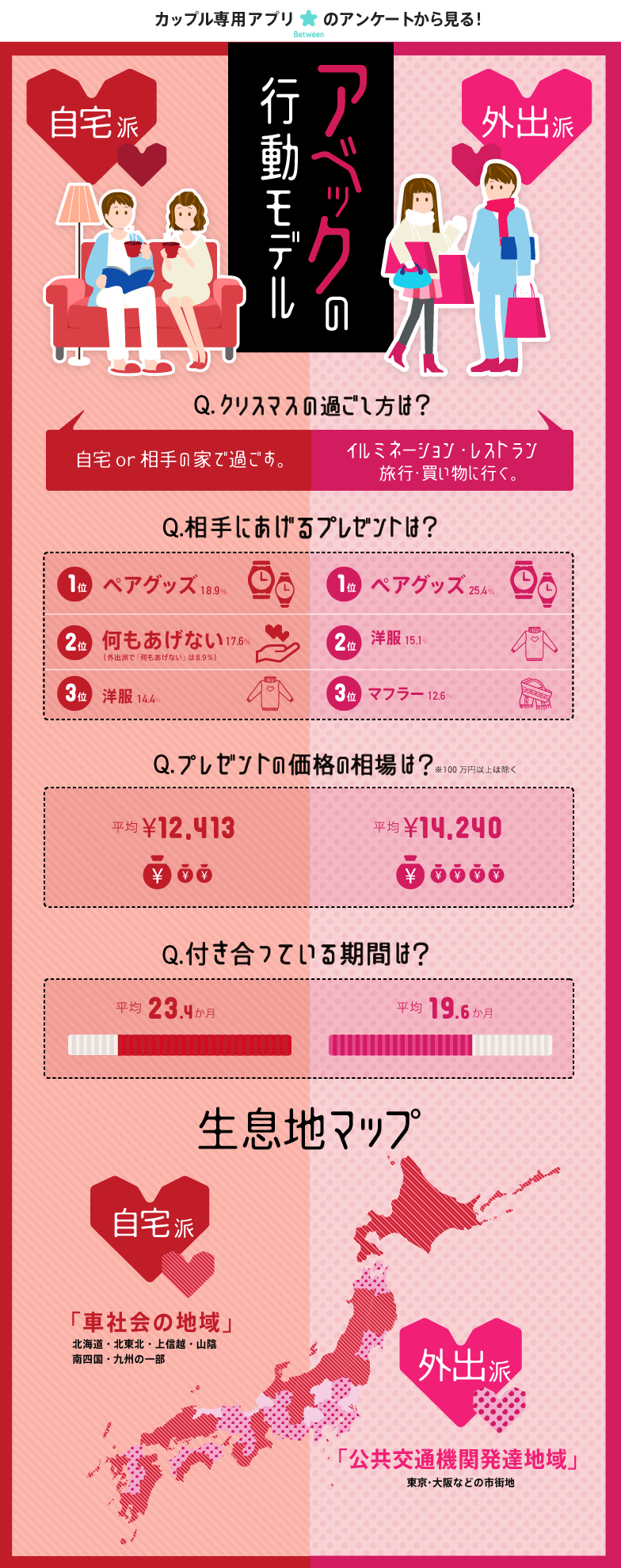
Leveraging Couple Behavior Insights for Marketing
By understanding couples' behaviors in this way, we can create various marketing activities with a new perspective, different from before.
For example, in areas with well-developed public transportation, encouraging couples to go out (illuminations being a prime example) could be leveraged for marketing. While encouraging outings in car-dependent areas is also possible, implementing strategies targeting couples who stay home might be effective. Furthermore, we found that as being a couple becomes routine, gift-giving becomes less active. Therefore, marketing efforts focused on creating special, non-routine experiences could also be beneficial.
This time, our team of older guys gained insights into couples' realities by analyzing their location data. This kind of user-centric analysis, achieved through collaboration with communication apps like Between, offers valuable suggestions for corporate marketing activities, especially when trying to grasp target audience insights.
Moving forward, we plan to expand our focus beyond couples to other target audiences and share insights accordingly.
*1 "Human Flow Lab" is
A research institute dedicated to realizing a more livable society by clarifying human flow patterns and disseminating information.
Contact: Dentsu Inc. Human Flow Lab
contact@hitononagarelab.jp














